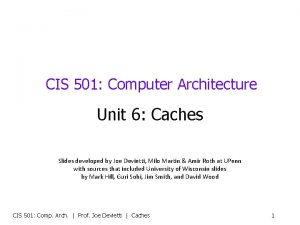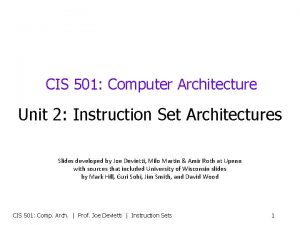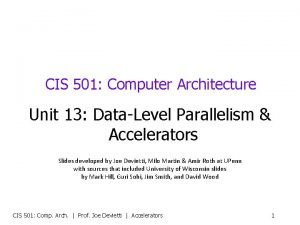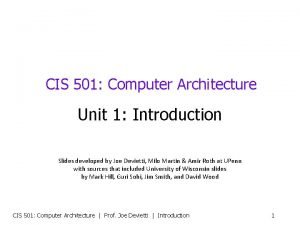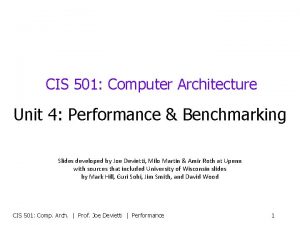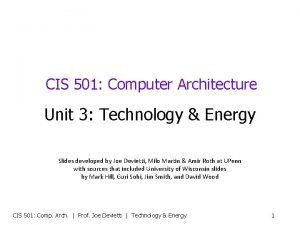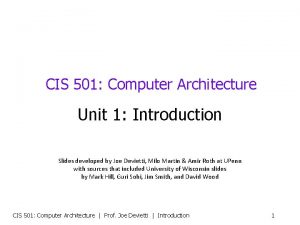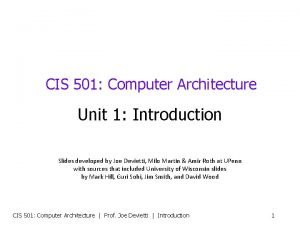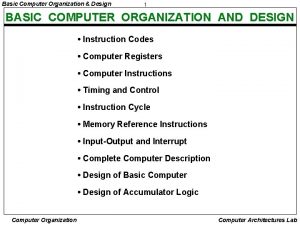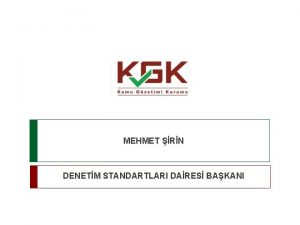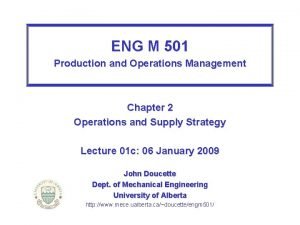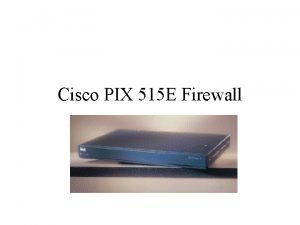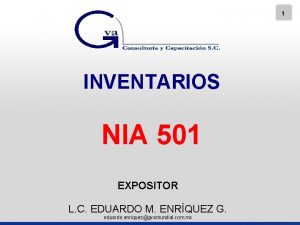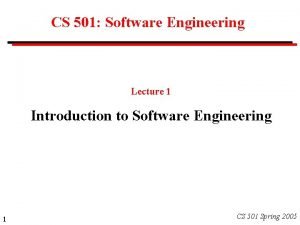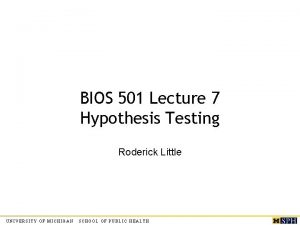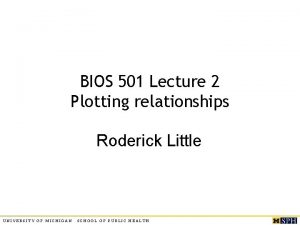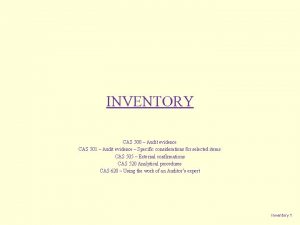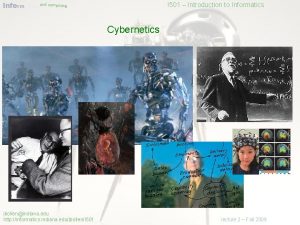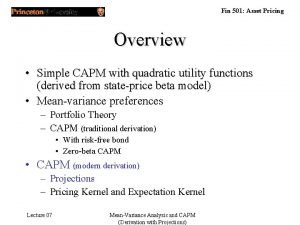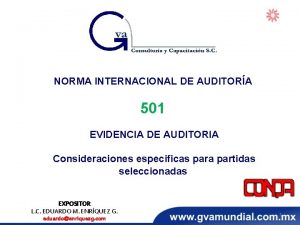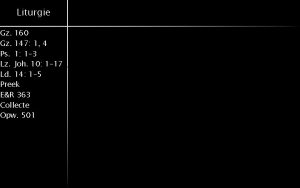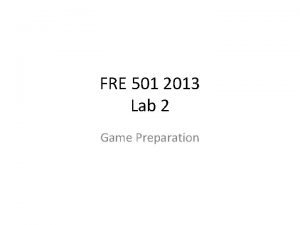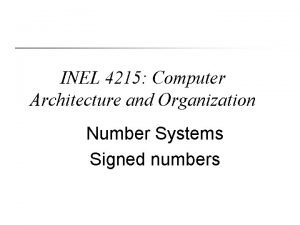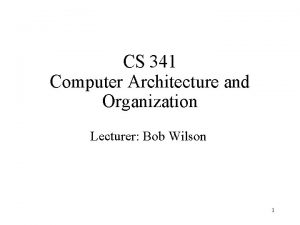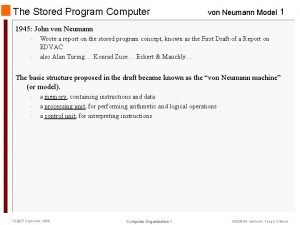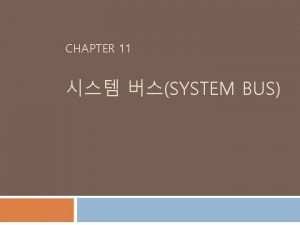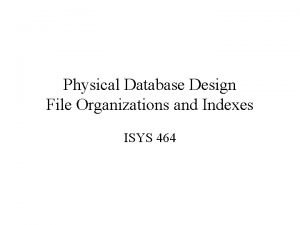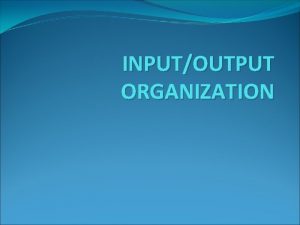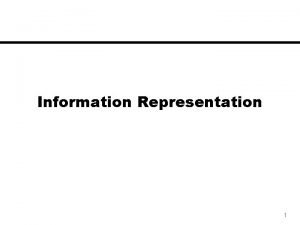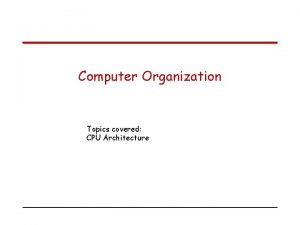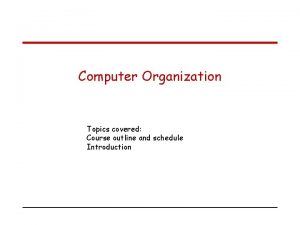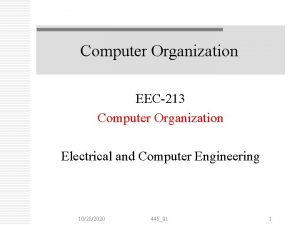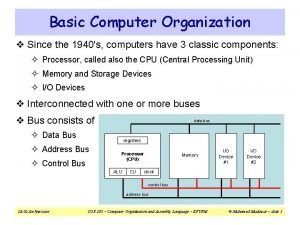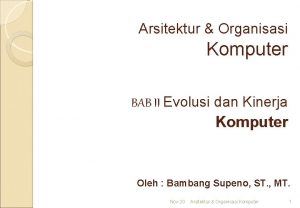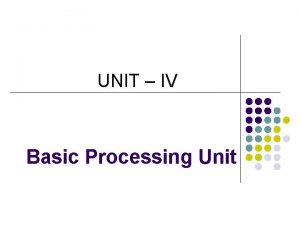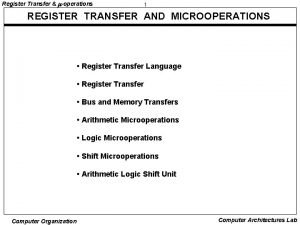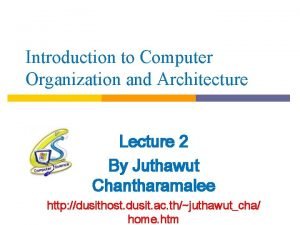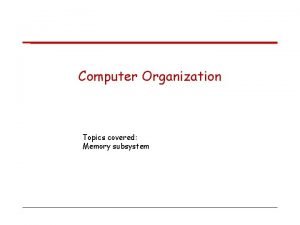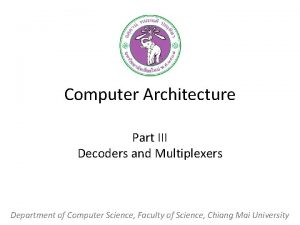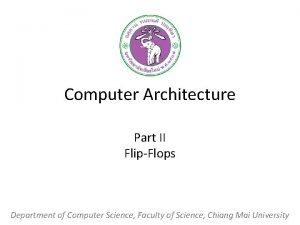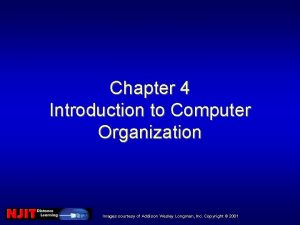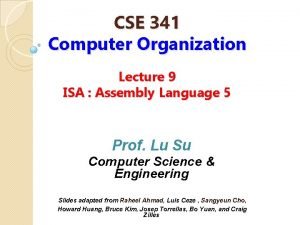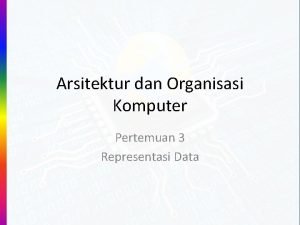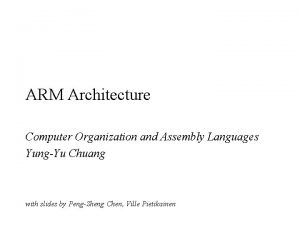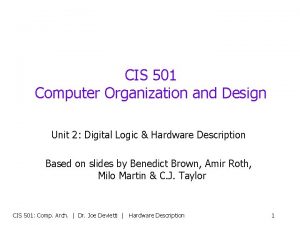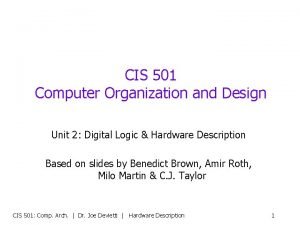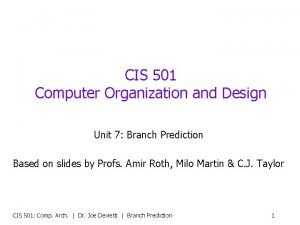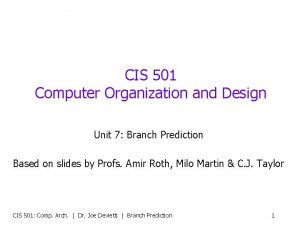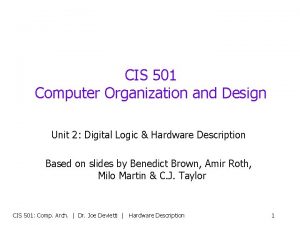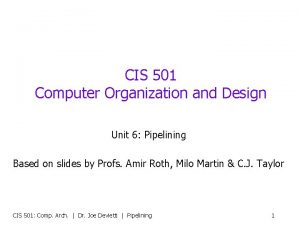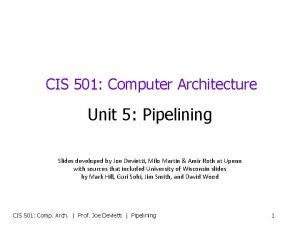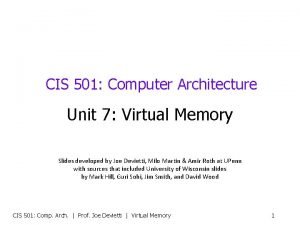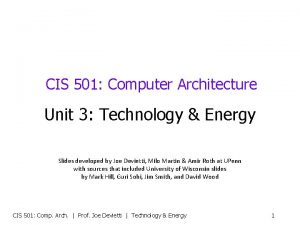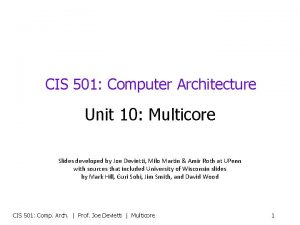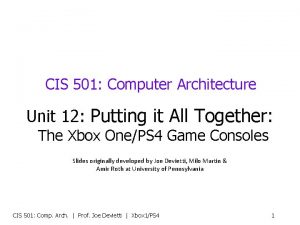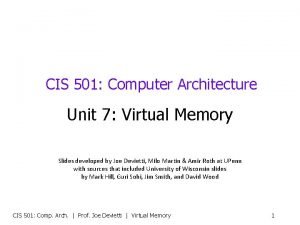CIS 501 Computer Organization and Design Unit 4










![240 Review: Program Compilation App App System software Mem CPU I/O int array[100], sum; 240 Review: Program Compilation App App System software Mem CPU I/O int array[100], sum;](https://slidetodoc.com/presentation_image/11c8a11c86c2a34fccdd9da0299d8ef2/image-11.jpg)
























![LC 4 Datapath +1 16 insn[2: 0] 3 insn[11: 9] insn[8: 6] 3 insn[11: LC 4 Datapath +1 16 insn[2: 0] 3 insn[11: 9] insn[8: 6] 3 insn[11:](https://slidetodoc.com/presentation_image/11c8a11c86c2a34fccdd9da0299d8ef2/image-36.jpg)























![Control Logic in Verilog opcode wire [31: 0] insn; wire [5: 0] func = Control Logic in Verilog opcode wire [31: 0] insn; wire [5: 0] func =](https://slidetodoc.com/presentation_image/11c8a11c86c2a34fccdd9da0299d8ef2/image-60.jpg)



![Decoder in Verilog (1 of 2) module decoder_2_to_4 (binary_in, onehot_out); input [1: 0] binary_in; Decoder in Verilog (1 of 2) module decoder_2_to_4 (binary_in, onehot_out); input [1: 0] binary_in;](https://slidetodoc.com/presentation_image/11c8a11c86c2a34fccdd9da0299d8ef2/image-64.jpg)
![Decoder in Verilog (2 of 2) module decoder_2_to_4 (binary_in, onehot_out); input [1: 0] binary_in; Decoder in Verilog (2 of 2) module decoder_2_to_4 (binary_in, onehot_out); input [1: 0] binary_in;](https://slidetodoc.com/presentation_image/11c8a11c86c2a34fccdd9da0299d8ef2/image-65.jpg)


















- Slides: 83

CIS 501 Computer Organization and Design Unit 4: Single-Cycle Datapath Based on slides by Profs. Benedict Brown, C. J. Taylor, Amir Roth & Milo Martin CIS 501 | Dr. Joe Devietti | ISAs & Single Cycle 1

This Unit: Single-Cycle Datapath App App System software Mem CPU I/O • • Overview of ISAs Datapath storage elements MIPS Datapath MIPS Control CIS 501 | Dr. Joe Devietti | ISAs & Single Cycle 2

Readings • P&H • Sections 4. 1 – 4. 4 CIS 501 | Dr. Joe Devietti | ISAs & Single Cycle 3

Recall from CIS 240… CIS 501 | Dr. Joe Devietti | ISAs & Single Cycle 4

240 Review: Applications App App System software Mem CPU I/O • Applications (Firefox, i. Tunes, Skype, Word, Google) • Run on hardware … but how? CIS 501 | Dr. Joe Devietti | ISAs & Single Cycle 5

240 Review: I/O App App System software Mem CPU I/O • Apps interact with us & each other via I/O (input/output) • • With us: display, sound, keyboard, mouse, touch-screen, camera With each other: disk, network (wired or wireless) Most I/O proper is analog-digital and domain of EE I/O devices present rest of computer a digital interface (1 s and 0 s) CIS 501 | Dr. Joe Devietti | ISAs & Single Cycle 6

240 Review: OS App App System software Mem CPU I/O • I/O (& other services) provided by OS (operating system) • A super-app with privileged access to all hardware • Abstracts away a lot of the nastiness of hardware • Virtualizes hardware to isolate programs from one another • Each application is oblivious to presence of others • Simplifies programming, makes system more robust and secure • Privilege is key to this • Commons OSes are Windows, Linux, Mac. OS CIS 501 | Dr. Joe Devietti | ISAs & Single Cycle 7

240 Review: ISA App App System software Mem CPU I/O • App/OS are software … execute on hardware • HW/SW interface is ISA (instruction set architecture) • A “contract” between SW and HW • Encourages compatibility, allows SW/HW to evolve independently • Functional definition of HW storage locations & operations • Storage locations: registers, memory • Operations: add, multiply, branch, load, store, etc. • Precise description of how to invoke & access them • Instructions (bit-patterns hardware interprets as commands) CIS 501 | Dr. Joe Devietti | ISAs & Single Cycle 8

240 Review: LC 4 ISA App App System software Mem CPU I/O • LC 4: a toy ISA you know • • • 16 -bit ISA (what does this mean? ) 16 -bit insns 8 registers (integer) ~30 different insns Simple OS support • Assembly language • Human-readable ISA representation CIS 501 | Dr. Joe Devietti | ISAs & Single Cycle . DATA array. BLKW #100 sum. FILL #0. CODE. FALIGN array_sum CONST R 5, #0 LEA R 1, array LEA R 2, sum array_sum_loop LDR R 3, R 1, #0 LDR R 4, R 2, #0 ADD R 4, R 3, R 4 STR R 4, R 2, #0 ADD R 1, #1 ADD R 5, #1 CMPI R 5, #100 BRn array_sum_loop 9

371/501 Preview: A Real ISA App App System software Mem CPU I/O • MIPS: example of real ISA • 32/64 -bit operations • 32 -bit insns • 64 registers • 32 integer, 32 floating point • ~100 different insns • Full OS support Example code is MIPS, but all ISAs are similar at some level CIS 501 | Dr. Joe Devietti | ISAs & Single Cycle . data array: . space 100 sum: . word 0. text array_sum: li $5, 0 la $1, array la $2, sum array_sum_loop: lw $3, 0($1) lw $4, 0($2) add $4, $3, $4 sw $4, 0($2) addi $1, 1 addi $5, 1 li $6, 100 blt $5, $6, array_sum_loop 10
![240 Review Program Compilation App App System software Mem CPU IO int array100 sum 240 Review: Program Compilation App App System software Mem CPU I/O int array[100], sum;](https://slidetodoc.com/presentation_image/11c8a11c86c2a34fccdd9da0299d8ef2/image-11.jpg)
240 Review: Program Compilation App App System software Mem CPU I/O int array[100], sum; void array_sum() { for (int i=0; i<100; i++) { sum += array[i]; } } • Program written in a “high-level” programming language • C, C++, Java, C# • Hierarchical, structured control: loops, functions, conditionals • Hierarchical, structured data: scalars, arrays, pointers, structures • Compiler: translates program to assembly • Parsing and straight-forward translation • Compiler also optimizes • Compiler itself another application … who compiled compiler? CIS 501 | Dr. Joe Devietti | ISAs & Single Cycle 11

240 Review: Assembly Language App App Machine code Assembly code System software Mem CPU I/O • Assembly language • Human-readable representation • Machine language • Machine-readable representation • 1 s and 0 s (often displayed in “hex”) • Assembler x 9 A 00 x 9200 x. D 320 x 9464 x. D 520 x 6640 x 6880 x 18 C 4 x 7880 x 1261 x 1 BA 1 x 2 B 64 x 03 F 8 CONST R 5, #0 CONST R 1, array HICONST R 1, array CONST R 2, sum HICONST R 2, sum LDR R 3, R 1, #0 LDR R 4, R 2, #0 ADD R 4, R 3, R 4 STR R 4, R 2, #0 ADD R 1, #1 ADD R 5, #1 CMPI R 5, #100 BRn array_sum_loop • Translates assembly to machine CIS 501 | Dr. Joe Devietti | ISAs & Single Cycle 12

240 Review: Insn Execution Model App App System software Mem CPU I/O • The computer is just finite state machine • Registers (few of them, but fast) • Memory (lots of memory, but slower) • Program counter (next insn to execute) • Sometimes called “instruction pointer” • A computer executes instructions Fetch Decode Read Inputs Execute Write Output Next Insn Instruction Insn • • • Fetches next instruction from memory Decodes it (figure out what it does) Reads its inputs (registers & memory) Executes it (adds, multiply, etc. ) Write its outputs (registers & memory) Next insn (adjust the program counter) • Program is just “data in memory” • Makes computers programmable (“universal”) CIS 501 | Dr. Joe Devietti | ISAs & Single Cycle 13

Role of the Compiler CIS 501 | Dr. Joe Devietti | ISAs & Single Cycle 14

Compiler Optimizations • Primarily goal: reduce instruction count • Eliminate redundant computation, keep more things in registers + Registers are faster, fewer loads/stores – An ISA can make this difficult by having too few registers • But also… • Reduce branches and jumps (later) • Reduce cache misses (later) • Reduce dependences between nearby insns (later) – An ISA can make this difficult by having implicit dependences • How effective are these? + Can give 4 X performance over unoptimized code – Collective wisdom of 40 years (“Proebsting’s Law”): 4% per year + Allows higher-level languages to perform adequately (Javascript) CIS 501 | Dr. Joe Devietti | ISAs & Single Cycle 15

Compiler Optimization Example (LC 4) ; ; temp = *first LDR R 7, R 5, #2 ; R 7=first LDR R 4, R 7, #0 STR R 4, R 5, #-1 ; ; *first = *second LDR R 3, R 5, #3 ; R 3=second LDR R 2, R 3, #0 LDR R 7, R 5, #2 ; redundant STR R 2, R 7, #0 ; ; *second = temp LDR R 4, R 5, #-1 LDR R 3, R 5, #3 ; redundant STR R 4, R 3, #0 ; ; temp = *first LDR R 7, R 5, #2 LDR R 4, R 7, #0 STR R 4, R 5, #-1 ; unneeded ; ; *first = *second LDR R 3, R 5, #3 LDR R 2, R 3, #0 STR R 2, R 7, #0 ; ; *second = temp LDR R 4, R 5, #-1 ; unneeded STR R 4, R 3, #0 • Left: common sub-expression elimination • Remove calculations whose results are already in some register • Right: register allocation • Keep temporary in register across statements, avoid stack spill/fill CIS 501 | Dr. Joe Devietti | ISAs & Single Cycle 16

What is an ISA? CIS 501 | Dr. Joe Devietti | ISAs & Single Cycle 17

What Is An ISA? • ISA (instruction set architecture) • A well-defined hardware/software interface • The “contract” between software and hardware • Functional definition of storage locations & operations • Storage locations: registers, memory • Operations: add, multiply, branch, load, store, etc • Precise description of how to invoke & access them • Not in the “contract”: non-functional aspects • How operations are implemented • Which operations are fast and which are slow and when • Which operations take more power and which take less • Instructions • Bit-patterns hardware interprets as commands • Instruction Insn (instruction is too long to write in slides) CIS 501 | Dr. Joe Devietti | ISAs & Single Cycle 18

A Language Analogy for ISAs • Communication • Person-to-person software-to-hardware • Similar structure • • • Narrative program Sentence insn Verb operation (add, multiply, load, branch) Noun data item (immediate, register value, memory value) Adjective addressing mode • Many different languages, many different ISAs • Similar basic structure, details differ (sometimes greatly) • Key differences between languages and ISAs • Languages evolve organically, many ambiguities, inconsistencies • ISAs are explicitly engineered and extended, unambiguous CIS 501 | Dr. Joe Devietti | ISAs & Single Cycle 19

LC 4 vs Real ISAs • LC 4 has the basic features of a real-world ISAs ± • • • LC 4 lacks a good bit of realism Address size is only 16 bits Only one data type (16 -bit signed integer) Little support for system software, none for multiprocessing (later) • Many real-world ISAs to choose from: • • Intel x 86 (laptops, desktop, and servers) MIPS (used throughout in book) ARM (in all your mobile phones) Power. PC (servers & game consoles) SPARC (servers) Intel’s Itanium Historical: IBM 370, VAX, Alpha, PA-RISC, 68 k, … CIS 501 | Dr. Joe Devietti | ISAs & Single Cycle 20

Some Key Attributes of ISAs • Instruction encoding • Fixed length (16 -bit for LC 4, 32 -bit for MIPS & ARM) • Variable length (1 byte to 16 bytes, average of ~3 bytes) • Number and type of registers • LC-4 has 8 registers • MIPS has 32 “integer” registers and 32 “floating point” registers • ARM & x 86 both have 16 “integer” regs and 16 “floating point” regs • Address space • LC 4: 16 -bit addresses at 16 -bit granularity (128 KB total) • ARM: 32 -bit addresses at 8 -bit granularly (4 GB total) • Modern x 86 and ARM 64: 64 -bit addresses (16 exabytes!) • Memory addressing modes • MIPS & LC 4: address calculated by “reg+offset” • x 86 and others have much more complicated addressing modes CIS 501 | Dr. Joe Devietti | ISAs & Single Cycle 21

Access Granularity & Alignment • Byte addressability • An address points to a byte (8 bits) of data • The ISA’s minimum granularity to read or write memory • ISAs also support wider load/stores • “Half” (2 bytes), “Longs” (4 bytes), “Quads” (8 bytes) 0 1 2 3 4 5 6 7 8 9 10 11 12 13 14 15 01001001 00101101001 11001011 00001001 01011000 00111001 11011101 • Load. byte [6] -> r 1 Load. long [12] -> r 2 However, physical memory systems operate on even larger chunks 0 1 2 3 4 5 6 7 8 9 10 11 12 13 14 15 01001001 00101101001 11001011 00001001 01011000 00111001 11011101 • Load. long [4] -> r 1 Load. long [11] -> r 2 “unaligned” • Access alignment: if address % size != 0, then it is “unaligned” • A single unaligned access may require multiple physical memory accesses CIS 501 | Dr. Joe Devietti | ISAs & Single Cycle 22

Handling Unaligned Accesses • Access alignment: if address % size != 0, then it is “unaligned” • A single unaligned access may require multiple physical memory accesses • How to handle such unaligned accesses? 1. Disallow (unaligned operations are considered illegal) • MIPS, ARMv 5 and earlier took this route 2. Support in hardware? (allow such operations) • x 86, ARMv 6+ allow regular loads/stores to be unaligned • Unaligned access still slower, adds significant hardware complexity 3. Trap to software routine? • Simpler hardware, but high penalty when unaligned 4. In software (compiler can use regular instructions when possibly unaligned • Load, shift, load, shift, and (slow, needs help from compiler) CIS 501 | Dr. Joe Devietti | ISAs & Single Cycle 23

How big is this struct? struct foo { char c; int i; } CIS 501 | Dr. Joe Devietti | ISAs & Single Cycle 24

Another Addressing Issue: Endian-ness • Endian-ness: arrangement of bytes in a multi-byte number • Big-endian: sensible order (e. g. , MIPS, Power. PC, ARM) • A 4 -byte integer: “ 0000000010 00000011” is 515 • Little-endian: reverse order (e. g. , x 86) • A 4 -byte integer: “ 00000011 00000010 00000000” is 515 • Why little endian? 00000011 00000010 00000000 starting address CIS 501 | Dr. Joe Devietti | ISAs & Single Cycle integer casts are free on little-endian architectures 25

ISA Code Examples CIS 501 | Dr. Joe Devietti | ISAs & Single Cycle 26

Array Sum Loop: LC 4. DATA array. BLKW #100 sum. FILL #0. CODE. FALIGN array_sum CONST R 5, #0 LEA R 1, array LEA R 2, sum L 1 LDR R 3, R 1, #0 LDR R 4, R 2, #0 ADD R 4, R 3, R 4 STR R 4, R 2, #0 ADD R 1, #1 ADD R 5, #1 CMPI R 5, #100 BRn L 1 CIS 501 | Dr. Joe Devietti | ISAs & Single Cycle int array[100]; int sum; void array_sum() { for (int i=0; i<100; i++) { sum += array[i]; } } 27

Array Sum Loop: LC 4 MIPS. DATA array. BLKW #100 sum. FILL #0. CODE. FALIGN array_sum CONST R 5, #0 LEA R 1, array LEA R 2, sum L 1 LDR R 3, R 1, #0 LDR R 4, R 2, #0 ADD R 4, R 3, R 4 STR R 4, R 2, #0 ADD R 1, #1 ADD R 5, #1 CMPI R 5, #100 BRn L 1 . data array: . space 100 sum: . word 0. text array_sum: li $5, 0 la $1, array la $2, sum L 1: lw $3, 0($1) lw $4, 0($2) add $4, $3, $4 sw $4, 0($2) addi $1, 1 addi $5, 1 li $6, 100 blt $5, $6, L 1 CIS 501 | Dr. Joe Devietti | ISAs & Single Cycle MIPS (right) similar to LC 4 Syntactic differences: register names begin with $ immediates are un-prefixed Only simple addressing modes syntax: displacement(reg) Left-most register is generally destination register 28

Array Sum Loop: LC 4 x 86. DATA array. BLKW #100 sum. FILL #0. CODE. FALIGN array_sum CONST R 5, #0 LEA R 1, array LEA R 2, sum L 1 LDR R 3, R 1, #0 LDR R 4, R 2, #0 ADD R 4, R 3, R 4 STR R 4, R 2, #0 ADD R 1, #1 ADD R 5, #1 CMPI R 5, #100 BRn L 1 . LFE 2. comm array, 400, 32. comm sum, 4, 4. globl array_sum: movl $0, -4(%rbp) x 86 (right) is different Syntactic differences: register names begin with % immediates begin with $ %rbp is base (frame) pointer . L 1: movl -4(%rbp), %eax movl array(, %eax, 4), %edx movl sum(%rip), %eax addl %edx, %eax Many addressing modes movl %eax, sum(%rip) addl $1, -4(%rbp) cmpl $99, -4(%rbp) jle. L 1 CIS 501 | Dr. Joe Devietti | ISAs & Single Cycle 29

x 86 Operand Model. LFE 2. comm array, 400, 32. comm sum, 4, 4. globl array_sum: movl $0, -4(%rbp) • x 86 uses explicit accumulators • Both register and memory • Distinguished by addressing mode Two operand insns (right-most is typically source & destination) . L 1: Register accumulator: %eax = %eax + %edx movl -4(%rbp), %eax movl array(, %eax, 4), %edx movl sum(%rip), %eax addl %edx, %eax “L” insn suffix and “%e…” reg. movl %eax, sum(%rip) prefix mean “ 32 -bit value” addl $1, -4(%rbp) cmpl $99, -4(%rbp) jle. L 1 Memory accumulator: Memory[%rbp-4] = Memory[%rbp-4] + 1 CIS 501 | Dr. Joe Devietti | ISAs & Single Cycle 30

CIS 501 | Dr. Joe Devietti | ISAs & Single Cycle 31

Implementing an ISA CIS 501 | Dr. Joe Devietti | ISAs & Single Cycle 32

Implementing an ISA datapath fetch PC Insn memory Register File Data Memory control • Datapath: performs computation (registers, ALUs, etc. ) • ISA specific: can implement every insn (single-cycle: in one pass!) • Control: determines which computation is performed • Routes data through datapath (which regs, which ALU op) • Fetch: get insn, translate opcode into control • Fetch Decode Execute “cycle” CIS 501 | Dr. Joe Devietti | ISAs & Single Cycle 33

Two Types of Components datapath fetch PC Insn memory Register File Data Memory control • Purely combinational: stateless computation • ALUs, muxes, control • Arbitrary Boolean functions • Combinational/sequential: storage • PC, insn/data memories, register file • Internally contain some combinational components CIS 501 | Dr. Joe Devietti | ISAs & Single Cycle 34

Example Datapath CIS 501 | Dr. Joe Devietti | ISAs & Single Cycle 35
![LC 4 Datapath 1 16 insn2 0 3 insn11 9 insn8 6 3 insn11 LC 4 Datapath +1 16 insn[2: 0] 3 insn[11: 9] insn[8: 6] 3 insn[11:](https://slidetodoc.com/presentation_image/11c8a11c86c2a34fccdd9da0299d8ef2/image-36.jpg)
LC 4 Datapath +1 16 insn[2: 0] 3 insn[11: 9] insn[8: 6] 3 insn[11: 9] PC 16 3’b 111 we r 1 sel r 2 sel 16 16 r 1 data 16 r 2 data ALU 16 Memory 216 by 16 16 bit 3 addr 16 we wsel Reg. File wdata out Memory 216 by 16 bit Reg. File in n/z/p 16 3 NZP Reg 3 Branch Logic we NZP Reg 16 CIS 501 | Dr. Joe Devietti | ISAs & Single Cycle 36

MIPS Datapath CIS 501 | Dr. Joe Devietti | ISAs & Single Cycle 37

Unified vs Split Memory Architecture datapath fetch PC Register File control Insn/Data Memory • Unified architecture: unified insn/data memory • “Harvard” architecture: split insn/data memories CIS 501 | Dr. Joe Devietti | ISAs & Single Cycle 38

Datapath for MIPS ISA • MIPS: 32 -bit instructions, registers are $0, $2… $31 • Consider only the following instructions add $1, $2, $3 $1 = $2 + $3 (add) addi $1, $2, 3 $1 = $2 + 3 (add immed) lw $1, 4($3) $1 = Memory[4+$3] (load) sw $1, 4($3) Memory[4+$3] = $1 (store) beq $1, $2, PC_relative_target (branch equal) j absolute_target (unconditional jump) • Why only these? • Most other instructions are the same from datapath viewpoint • The ones that aren’t are left for you to figure out CIS 501 | Dr. Joe Devietti | ISAs & Single Cycle 39

MIPS Instruction layout CIS 501 | Dr. Joe Devietti | ISAs & Single Cycle 40

Start With Fetch + 4 P C Insn Mem • PC and instruction memory (split insn/data architecture, for now) • A +4 incrementer computes default next instruction PC • How would Verilog for this look given insn memory as interface? CIS 501 | Dr. Joe Devietti | ISAs & Single Cycle 41

First Instruction: add + 4 P C Insn Mem Register File s 1 s 2 d R-type Op(6) Rs(5) Rt(5) Rd(5) Sh(5) Func(6) • Add register file • Add arithmetic/logical unit (ALU) CIS 501 | Dr. Joe Devietti | ISAs & Single Cycle 42

Wire Select in Verilog • How to rip out individual fields of an insn? Wire select wire [31: 0] insn; wire [5: 0] op = insn[31: 26]; wire [4: 0] rs = insn[25: 21]; wire [4: 0] rt = insn[20: 16]; wire [4: 0] rd = insn[15: 11]; wire [4: 0] sh = insn[10: 6]; wire [5: 0] func = insn[5: 0]; R-type Op(6) Rs(5) Rt(5) Rd(5) Sh(5) Func(6) CIS 501 | Dr. Joe Devietti | ISAs & Single Cycle 43

Second Instruction: addi + 4 P C Insn Mem Register File s 1 s 2 d S X I-type Op(6) Rs(5) Rt(5) Immed(16) • Destination register can now be either Rd or Rt • Add sign extension unit and mux into second ALU input CIS 501 | Dr. Joe Devietti | ISAs & Single Cycle 44

Verilog Wire Concatenation • Recall two Verilog constructs • Wire concatenation: {bus 0, bus 1, … , busn} • Wire repeat: {repeat_x_times{w 0}} • How do you specify sign extension? Wire concatenation wire [31: 0] insn; wire [15: 0] imm 16 = insn[15: 0]; wire [31: 0] sximm 16 = {{16{imm 16[15]}}, imm 16}; I-type Op(6) Rs(5) Rt(5) CIS 501 | Dr. Joe Devietti | ISAs & Single Cycle Immed(16) 45

Third Instruction: lw + 4 P C Insn Mem a Register File Data d Mem s 1 s 2 d S X I-type Op(6) Rs(5) Rt(5) Immed(16) • Add data memory, address is ALU output • Add register write data mux to select memory output or ALU output CIS 501 | Dr. Joe Devietti | ISAs & Single Cycle 46

Fourth Instruction: sw + 4 P C Insn Mem a Register File Data d Mem s 1 s 2 d S X I-type Op(6) Rs(5) Rt(5) Immed(16) • Add path from second input register to data memory data input CIS 501 | Dr. Joe Devietti | ISAs & Single Cycle 47

Fifth Instruction: beq << 2 + 4 P C Insn Mem z Register File s 1 s 2 d a Data d Mem S X I-type Op(6) Rs(5) Rt(5) Immed(16) • Add left shift unit and adder to compute PC-relative branch target • Add PC input mux to select PC+4 or branch target CIS 501 | Dr. Joe Devietti | ISAs & Single Cycle 48

Another Use of Wire Concatenation • How do you do <<2? Wire concatenation wire [31: 0] insn; wire [25: 0] imm 26 = insn[25: 0] wire [31: 0] imm 26_shifted_by_2 = {4’b 0000, imm 26, 2’b 00}; Op(6) Immed(26) CIS 501 | Dr. Joe Devietti | ISAs & Single Cycle 49

Sixth Instruction: j << 2 + 4 P C Insn Mem << 2 a Register File Data d Mem s 1 s 2 d S X J-type Op(6) Immed(26) • Add shifter to compute left shift of 26 -bit immediate • Add additional PC input mux for jump target CIS 501 | Dr. Joe Devietti | ISAs & Single Cycle 50

MIPS Control CIS 501 | Dr. Joe Devietti | ISAs & Single Cycle 51

What Is Control? << 2 + 4 P C Insn Mem << 2 Data d Mem s 1 s 2 d S X Rdst JP a Register File Rwe BR ALUop Rwd DMwe ALUin. B • 8 signals control flow of data through this datapath • MUX selectors, or register/memory write enable signals • A real datapath has 300 -500 control signals CIS 501 | Dr. Joe Devietti | ISAs & Single Cycle 52

Example: Control for add << 2 + 4 P C Insn Mem << 2 Data d Mem s 1 s 2 d S X Rdst=1 CIS 501 | Dr. Joe Devietti | ISAs & Single Cycle JP=0 a Register File Rwe=1 BR=0 Rwd=0 ALUop=0 DMwe=0 ALUin. B=0 53

Example: Control for sw << 2 + 4 P C Insn Mem << 2 BR=0 a Register File Data d Mem s 1 s 2 d S X Rwe=0 Rdst=X JP=0 Rwd=X ALUop=0 DMwe=1 ALUin. B=1 • Difference between sw and add is 5 signals • 3 if you don’t count the X (don’t care) signals CIS 501 | Dr. Joe Devietti | ISAs & Single Cycle 54

Example: Control for beq << 2 + 4 P C Insn Mem << 2 Data d Mem s 1 s 2 d S X Rdst=X JP=0 a Register File Rwe=0 BR=1 Rwd=X ALUop=1 DMwe=0 ALUin. B=0 • Difference between sw and beq is only 4 signals CIS 501 | Dr. Joe Devietti | ISAs & Single Cycle 55

How Is Control Implemented? << 2 + 4 P C Insn Mem << 2 Data d Mem s 1 s 2 d S X Rdst JP a Register File Rwe BR ALUop Rwd DMwe ALUin. B Control? CIS 501 | Dr. Joe Devietti | ISAs & Single Cycle 56

Implementing Control • Each instruction has a unique set of control signals • Most are function of opcode • Some may be encoded in the instruction itself • E. g. , the ALUop signal is some portion of the MIPS Func field + Simplifies controller implementation • Requires careful ISA design CIS 501 | Dr. Joe Devietti | ISAs & Single Cycle 57

Control Implementation: ROM • ROM (read only memory): like a RAM but unwritable • • Bits in data words are control signals Lines indexed by opcode Example: ROM control for 6 -insn MIPS datapath X is “don’t care” opcode BR JP ALUin. B add 0 0 0 1 0 0 addi 0 0 1 1 0 lw 0 0 1 1 1 sw 0 0 1 0 X X beq 1 0 0 X X j 0 1 0 0 X X CIS 501 | Dr. Joe Devietti | ISAs & Single Cycle ALUop DMwe Rdst Rwd 58

Control Implementation: Logic • Real machines have 100+ insns 300+ control signals • 30, 000+ control bits (~4 KB) – Not huge, but hard to make faster than datapath (important!) • Alternative: logic gates or “random logic” (unstructured) opcode • Exploits the observation: many signals have few 1 s or few 0 s • Example: random logic control for 6 -insn MIPS datapath addi lw sw beq j BR JP DMwe CIS 501 | Dr. Joe Devietti | ISAs & Single Cycle Rwd Rdst ALUop ALUin. B 59
![Control Logic in Verilog opcode wire 31 0 insn wire 5 0 func Control Logic in Verilog opcode wire [31: 0] insn; wire [5: 0] func =](https://slidetodoc.com/presentation_image/11c8a11c86c2a34fccdd9da0299d8ef2/image-60.jpg)
Control Logic in Verilog opcode wire [31: 0] insn; wire [5: 0] func = insn[5: 0] wire [5: 0] opcode = insn[31: 26]; wire is_add = ((opcode == 6’h 00) & (func == 6’h 20)); wire is_addi = (opcode == 6’h 0 F); wire is_lw = (opcode == 6’h 23); wire is_sw = (opcode == 6’h 2 A); wire ALUin. B = is_addi | is_lw | is_sw; wire Rwe = is_add | is_addi | is_lw; wire Rwd = is_lw; add wire Rdst = ~is_add; addi wire DMwe = is_sw; lw sw DMwe CIS 501 | Dr. Joe Devietti | ISAs & Single Cycle Rwd Rdst ALUin. B 60

Datapath Storage Elements CIS 501 | Dr. Joe Devietti | ISAs & Single Cycle 61

Register File Reg. Source 1 Val Reg. Dest. Val Register File WE Reg. Source 2 Val RD RS 1 RS 2 • Register file: M N-bit storage words • Multiplexed input/output: data buses write/read “random” word • “Port”: set of buses for accessing a random word in array • Data bus (N-bits) + address bus (log 2 M-bits) + optional WE bit • P ports = P parallel and independent accesses • MIPS integer register file • 32 32 -bit words, two read ports + one write port (why? ) CIS 501 | Dr. Joe Devietti | ISAs & Single Cycle 62

Decoder • Decoder: converts binary integer to “ 1 -hot” representation • Binary representation of 0… 2 N– 1: N bits • 1 hot representation of 0… 2 N– 1: 2 N bits • J represented as Jth bit 1, all other bits zero • Example below: 2 -to-4 decoder B[0] B[1] 1 H[0] 1 H[1] B 1 H 1 H[2] 1 H[3] CIS 501 | Dr. Joe Devietti | ISAs & Single Cycle 63
![Decoder in Verilog 1 of 2 module decoder2to4 binaryin onehotout input 1 0 binaryin Decoder in Verilog (1 of 2) module decoder_2_to_4 (binary_in, onehot_out); input [1: 0] binary_in;](https://slidetodoc.com/presentation_image/11c8a11c86c2a34fccdd9da0299d8ef2/image-64.jpg)
Decoder in Verilog (1 of 2) module decoder_2_to_4 (binary_in, onehot_out); input [1: 0] binary_in; output [3: 0] onehot_out; assign onehot_out[0] = (~binary_in[0] & ~binary_in[1]); assign onehot_out[1] = (~binary_in[0] & binary_in[1]); assign onehot_out[2] = (binary_in[0] & ~binary_in[1]); assign onehot_out[3] = (binary_in[0] & binary_in[1]); endmodule • Is there a simpler way? CIS 501 | Dr. Joe Devietti | ISAs & Single Cycle 64
![Decoder in Verilog 2 of 2 module decoder2to4 binaryin onehotout input 1 0 binaryin Decoder in Verilog (2 of 2) module decoder_2_to_4 (binary_in, onehot_out); input [1: 0] binary_in;](https://slidetodoc.com/presentation_image/11c8a11c86c2a34fccdd9da0299d8ef2/image-65.jpg)
Decoder in Verilog (2 of 2) module decoder_2_to_4 (binary_in, onehot_out); input [1: 0] binary_in; output [3: 0] onehot_out; assign onehot_out[0] = (binary_in == 2’d 0); assign onehot_out[1] = (binary_in == 2’d 1); assign onehot_out[2] = (binary_in == 2’d 2); assign onehot_out[3] = (binary_in == 2’d 3); endmodule • How is “a == b“ implemented for vectors? • ~|(a ^ b) (this is a “nor” reduction of bitwise “a xor b”) • When one of the inputs to “==“ is a constant • Simplifies to simpler inverter on bits with “one” in constant • Exactly what was on previous slide! (apply De. Morgan’s law) CIS 501 | Dr. Joe Devietti | ISAs & Single Cycle 65

Register File Interface RDest. Val RSrc 2 Val RSrc 1 Val WE RD RS 2 RS 1 • Inputs: • RS 1, RS 2 (reg. sources to read), RD (reg. destination to write) • WE (write enable), RDest. Val (value to write) • Outputs: RSrc 1 Val, RSrc 2 Val (value of RS 1 & RS 2 registers) CIS 501 | Dr. Joe Devietti | ISAs & Single Cycle 66

Register File: Four Registers • Register file with four registers CIS 501 | Dr. Joe Devietti | ISAs & Single Cycle 67

Add a Read Port RSrc 1 Val RS 1 • Output of each register into 4 to 1 mux (RSrc 1 Val) • RS 1 is select input of RSrc 1 Val mux CIS 501 | Dr. Joe Devietti | ISAs & Single Cycle 68

Add Another Read Port RSrc 2 Val RSrc 1 Val RS 2 RS 1 • Output of each register into another 4 to 1 mux (RSrc 2 Val) • RS 2 is select input of RSrc 2 Val mux CIS 501 | Dr. Joe Devietti | ISAs & Single Cycle 69

Add a Write Port RDest. Val RSrc 2 Val RSrc 1 Val WE RD RS 2 RS 1 • Input Reg. Dest. Val into each register • Enable only one register’s WE: (Decoded RD) & (WE) • What if we needed two write ports? CIS 501 | Dr. Joe Devietti | ISAs & Single Cycle 70

Register File Interface (Verilog) module regfile 4(rs 1, rs 1 val, rs 2 val, rdval, we, rst, clk); parameter n = 1; input [1: 0] rs 1, rs 2, rd; input we, rst, clk; input [n-1: 0] rdval; output [n-1: 0] rs 1 val, rs 2 val; … endmodule • Building block modules: • • • module register (out, in, wen, rst, clk); module decoder_2_to_4 (binary_in, onehot_out) module Nbit_mux 4 to 1 (sel, a, b, c, d, out); CIS 501 | Dr. Joe Devietti | ISAs & Single Cycle 71

Register File Interface (Verilog) module regfile 4(rs 1, rs 1 val, rs 2 val, rdval, we, rst, clk); input [1: 0] rs 1, rs 2, rd; input we, rst, clk; input [15: 0] rdval; output [15: 0] rs 1 val, rs 2 val; endmodule • Warning: this code not tested, may contain typos, do not blindly trust! CIS 501 | Dr. Joe Devietti | ISAs & Single Cycle 72

Register File Interface (Verilog) module regfile 4(rs 1, rs 1 val, rs 2 val, rdval, we, rst, clk); parameter n = 1; input [1: 0] rs 1, rs 2, rd; input we, rst, clk; input [n-1: 0] rdval; output [n-1: 0] rs 1 val, rs 2 val; endmodule • Warning: this code not tested, may contain typos, do not blindly trust! CIS 501 | Dr. Joe Devietti | ISAs & Single Cycle 73

Register File: Four Registers (Verilog) module regfile 4(rs 1, rs 1 val, rs 2 val, rdval, we, rst, clk); parameter n = 1; input [1: 0] rs 1, rs 2, rd; input we, rst, clk; input [n-1: 0] rdval; output [n-1: 0] rs 1 val, rs 2 val; wire [n-1: 0] r 0 v, r 1 v, r 2 v, r 3 v; Nbit_reg #(n) r 0 (r 0 v, Nbit_reg #(n) r 1 (r 1 v, Nbit_reg #(n) r 2 (r 2 v, Nbit_reg #(n) r 3 (r 3 v, , rst, clk); , rst, clk); endmodule • Warning: this code not tested, may contain typos, do not blindly trust! CIS 501 | Dr. Joe Devietti | ISAs & Single Cycle 74

Add a Read Port (Verilog) module regfile 4(rs 1, rs 1 val, rs 2 val, rdval, we, rst, clk); parameter n = 1; input [1: 0] rs 1, rs 2, rd; input we, rst, clk; input [n-1: 0] rdval; output [n-1: 0] rs 1 val, rs 2 val; wire [n-1: 0] r 0 v, r 1 v, r 2 v, r 3 v; Nbit_reg #(n) r 0 (r 0 v, , , rst, clk); Nbit_reg #(n) r 1 (r 1 v, , , rst, clk); Nbit_reg #(n) r 2 (r 2 v, , , rst, clk); Nbit_reg #(n) r 3 (r 3 v, , , rst, clk); Nbit_mux 4 to 1 #(n) mux 1 (rs 1, r 0 v, r 1 v, r 2 v, r 3 v, rs 1 val); endmodule • Warning: this code not tested, may contain typos, do not blindly trust! CIS 501 | Dr. Joe Devietti | ISAs & Single Cycle 75

Add Another Read Port (Verilog) module regfile 4(rs 1, rs 1 val, rs 2 val, rdval, we, rst, clk); parameter n = 1; input [1: 0] rs 1, rs 2, rd; input we, rst, clk; input [n-1: 0] rdval; output [n-1: 0] rs 1 val, rs 2 val; wire [n-1: 0] r 0 v, r 1 v, r 2 v, r 3 v; Nbit_reg #(n) r 0 (r 0 v, , , rst, clk); Nbit_reg #(n) r 1 (r 1 v, , , rst, clk); Nbit_reg #(n) r 2 (r 2 v, , , rst, clk); Nbit_reg #(n) r 3 (r 3 v, , , rst, clk); Nbit_mux 4 to 1 #(n) mux 1 (rs 1, r 0 v, r 1 v, r 2 v, r 3 v, rs 1 val); Nbit_mux 4 to 1 #(n) mux 2 (rs 2, r 0 v, r 1 v, r 2 v, r 3 v, rs 2 val); endmodule • Warning: this code not tested, may contain typos, do not blindly trust! CIS 501 | Dr. Joe Devietti | ISAs & Single Cycle 76

Add a Write Port (Verilog) module regfile 4(rs 1, rs 1 val, rs 2 val, rdval, we, rst, clk); parameter n = 1; input [1: 0] rs 1, rs 2, rd; input we, rst, clk; input [n-1: 0] rdval; output [n-1: 0] rs 1 val, rs 2 val; wire [n-1: 0] r 0 v, r 1 v, r 2 v, r 3 v; wire [3: 0] rd_select; decoder_2_to_4 dec (rd, rd_select); Nbit_reg #(n) r 0 (r 0 v, rdval, rd_select[0] & we, rst, clk); Nbit_reg #(n) r 1 (r 1 v, rdval, rd_select[1] & we, rst, clk); Nbit_reg #(n) r 2 (r 2 v, rdval, rd_select[2] & we, rst, clk); Nbit_reg #(n) r 3 (r 3 v, rdval, rd_select[3] & we, rst, clk); Nbit_mux 4 to 1 #(n) mux 1 (rs 1, r 0 v, r 1 v, r 2 v, r 3 v, rs 1 val); Nbit_mux 4 to 1 #(n) mux 2 (rs 2, r 0 v, r 1 v, r 2 v, r 3 v, rs 2 val); endmodule • Warning: this code not tested, may contain typos, do not blindly trust! CIS 501 | Dr. Joe Devietti | ISAs & Single Cycle 77

Final Register File (Verilog) module regfile 4(rs 1, rs 1 val, rs 2 val, rdval, we, rst, clk); parameter n = 1; input [1: 0] rs 1, rs 2, rd; input we, rst, clk; input [n-1: 0] rdval; output [n-1: 0] rs 1 val, rs 2 val; wire [n-1: 0] r 0 v, r 1 v, r 2 v, r 3 v; Nbit_reg #(n) r 0 (r 0 v, rdval, (rd == 2’d 0) & we, rst, clk); Nbit_reg #(n) r 1 (r 1 v, rdval, (rd == 2’d 1) & we, rst, clk); Nbit_reg #(n) r 2 (r 2 v, rdval, (rd == 2’d 2) & we, rst, clk); Nbit_reg #(n) r 3 (r 3 v, rdval, (rd == 2’d 3) & we, rst, clk); Nbit_mux 4 to 1 #(n) mux 1 (rs 1, r 0 v, r 1 v, r 2 v, r 3 v, rs 1 val); Nbit_mux 4 to 1 #(n) mux 2 (rs 2, r 0 v, r 1 v, r 2 v, r 3 v, rs 2 val); endmodule • Warning: this code not tested, may contain typos, do not blindly trust! CIS 501 | Dr. Joe Devietti | ISAs & Single Cycle 78

Another Useful Component: Memory DATAIN DATAOUT ADDRESS Memory WE • Register file: M N-bit storage words • Few words (< 256), many ports, dedicated read and write ports • Memory: M N-bit storage words, yet not a register file • Many words (> 1024), few ports (1, 2), shared read/write ports • Leads to different implementation choices • Lots of circuit tricks and such • Larger memories typically only 6 transistors per bit • In Verilog? We’ll give you the code for large memories CIS 501 | Dr. Joe Devietti | ISAs & Single Cycle 79

Single-Cycle Performance CIS 501 | Dr. Joe Devietti | ISAs & Single Cycle 80

Single-Cycle Datapath Performance << 2 + 4 P C Insn Mem Register File a Data d. Mem s 1 s 2 d S X • One cycle per instruction (CPI) • Clock cycle time proportional to worst-case logic delay • In this datapath: insn fetch, decode, register read, ALU, data memory access, write register • Can we do better? CIS 501 | Dr. Joe Devietti | ISAs & Single Cycle 81

Foreshadowing: Pipelined Datapath PC PC << 2 + 4 PC Insn Mem Register File s 1 s 2 d A O O B B a Data d. Mem D S X IR IR • Split datapath into multiple stages • Assembly line analogy • 5 stages results in up to 5 x clock & performance improvement CIS 501 | Dr. Joe Devietti | ISAs & Single Cycle 82

Summary App App System software Mem CPU I/O • • Overview of ISAs Datapath storage elements MIPS Datapath MIPS Control CIS 501 | Dr. Joe Devietti | ISAs & Single Cycle 83
 Cis 501
Cis 501 Cis 501
Cis 501 Cis 501
Cis 501 Cis 501
Cis 501 Cis 501
Cis 501 Cis 501
Cis 501 Cis 501
Cis 501 Joe devietti
Joe devietti Process organization in computer organization
Process organization in computer organization Architecture and organization difference
Architecture and organization difference Basic computer organization and design
Basic computer organization and design Computer organization and design ppt
Computer organization and design ppt Basic computer design
Basic computer design Basic computer organization and design
Basic computer organization and design Basic structure of a computer
Basic structure of a computer Point-by-point organization
Point-by-point organization Salarisschaal 501
Salarisschaal 501 501 rimskymi cislicami
501 rimskymi cislicami Bds 501
Bds 501 Hinario 501
Hinario 501 Eng 501
Eng 501 Ariane 5 flight 501
Ariane 5 flight 501 Dev 501
Dev 501 Cisco pix 500
Cisco pix 500 Nia 501
Nia 501 Tyler sis webster groves
Tyler sis webster groves Hinario 501
Hinario 501 Cs-501
Cs-501 Bios 501
Bios 501 Bios 501
Bios 501 Mgt 501
Mgt 501 Mgt 501
Mgt 501 Cas 501
Cas 501 I 501
I 501 I 501
I 501 Mgt501 human resource management
Mgt501 human resource management Turnus 501
Turnus 501 501
501 501
501 Norma 501
Norma 501 Opwekking 501
Opwekking 501 W 501
W 501 Maurice cooper
Maurice cooper Ubc canvs
Ubc canvs Unit 6 review questions
Unit 6 review questions Computer organization and architecture 10th solution
Computer organization and architecture 10th solution Iit kharagpur virtual lab
Iit kharagpur virtual lab Introduction to computer organization and architecture
Introduction to computer organization and architecture Computer organization & architecture: themes and variations
Computer organization & architecture: themes and variations Computer organization and architecture 10th edition
Computer organization and architecture 10th edition William stallings computer organization and architecture
William stallings computer organization and architecture Computer organization and architecture definition
Computer organization and architecture definition 1 s complement
1 s complement Computer architecture and organization
Computer architecture and organization Modello von neumann
Modello von neumann Synchronous and asynchronous bus in computer organization
Synchronous and asynchronous bus in computer organization File organization and database design
File organization and database design Nano programming
Nano programming Three bus architecture
Three bus architecture Accessing io devices
Accessing io devices Information representation in computer architecture
Information representation in computer architecture Organization of digital computer
Organization of digital computer Single bus structure in computer organization
Single bus structure in computer organization Computer organization course
Computer organization course Single bus structure in computer organization
Single bus structure in computer organization Lan popo
Lan popo Basic computer organization
Basic computer organization Herdaynote arsitektur memori
Herdaynote arsitektur memori Wide branch addressing in computer organization
Wide branch addressing in computer organization Register transfer operation
Register transfer operation Organisasi komputer
Organisasi komputer Subroutine in computer architecture
Subroutine in computer architecture Internal organization of memory chips
Internal organization of memory chips Encoder and decoder in computer architecture
Encoder and decoder in computer architecture D flip flop in computer architecture
D flip flop in computer architecture Computer organization images
Computer organization images Mehul khatiwala
Mehul khatiwala Cse 341
Cse 341 Structured computer organization
Structured computer organization Cost performance ratio computer architecture
Cost performance ratio computer architecture Flynn's classification in computer organization
Flynn's classification in computer organization What is computer organization
What is computer organization Karakter alfanumerik
Karakter alfanumerik Arm architecture and organization
Arm architecture and organization
